|
|
|
Sort Order |
|
|
|
Items / Page
|
|
|
|
|
|
|
| Srl | Item |
| 1 |
ID:
156092
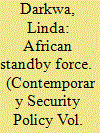

|
|
|
|
|
| Summary/Abstract |
Declared operationally ready in 2016, the African Standby Force (ASF) has not been deployed in its originally designed form. This is not for the lack of opportunities but rather a demonstration of the power of the Regional Economic Communities/Regional Mechanisms (RECs/RMs) – Africa’s sub-regional security structures – over matters of peace and security. Experience gathered from its short existence suggests that the ASF may never be deployed in its current form. It may instead evolve into a robust framework, adaptable mainly by the RECs/RMs, for addressing varied security challenges. Four things are critical to enhancing the utility of the ASF: the political willingness of the RECs/RMs, the strategic interest of the member states, predictable and sustainable financing, and clarity on the role of the African Capability for Immediate Response to Crisis, the temporary battlegroup that was created to provide the African Union with a rapid response capability, pending the ASF’s operationalization.
|
|
|
|
|
|
|
|
|
|
|
|
|
|
|
|
| 2 |
ID:
156086
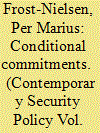

|
|
|
|
|
| Summary/Abstract |
Why do states make substantial military contributions to coalition operations, while at the same time apply reservations, or caveats, to how the coalition can use the military contributions? Caveats rose to prominence in defense and policy circles with NATO’s campaign in Afghanistan. In the scholarly security literature, the term remains a buzzword for all types of reserved efforts by states in coalition warfare, but there are few theoretical accounts addressing caveats. This article contributes to the knowledge gap on caveats through a comparative case study of Denmark’s, the Netherlands’, and Norway’s contributions to NATO’s intervention in Libya in 2011. It demonstrates that caveats can occur through three different causal pathways: compromises from domestic bargaining, handling of alliance commitments, and implementation and civil–military relations. Insights into the complexity that causes caveats are highly relevant for both political and military decision-makers that are trying to coordinate states’ effort in coalition operations.
|
|
|
|
|
|
|
|
|
|
|
|
|
|
|
|
| 3 |
ID:
156085
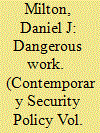

|
|
|
|
|
| Summary/Abstract |
The goal of diplomats is to represent their countries’ interests through diplomacy, not arms. Because they are not military personnel, they may be perceived as at lower risk of being the target of terrorists. However, recent events have called this perception into question. Despite this danger, there has been little research on terrorist attacks against diplomats. Drawing on the terrorism studies literature, this article argues that diplomats are targeted more than non-diplomatic targets in countries where certain U.S. foreign policies are implemented. An empirical analysis of 471 attacks against U.S. diplomats from 1970 to 2011 reveals that while U.S. alliances and foreign aid increase the likelihood of attacks against diplomats, U.S. military intervention and civil war, on the other hand, increase the risk of terrorism against non-diplomatic targets. This finding is relevant because it shows terrorist attacks against diplomats result from certain types of foreign policy.
|
|
|
|
|
|
|
|
|
|
|
|
|
|
|
|
| 4 |
ID:
156091
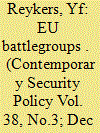

|
|
|
|
|
| Summary/Abstract |
This article reviews the gloomy saga of the EU Battlegroups, focusing on four questions: Where do they come from? What do they look like? What have they been hindered by? And where do they go from here? It builds upon earlier findings in the literature and adds novel insights based on original data. In doing so, the article pays particular attention to the standby nations’ constant calculation of political and financial costs. It argues that recognizing these cost–benefit calculations allows for identifying the most crucial areas to be tackled to make the EU Battlegroups functional. In addition, the article stresses that these considerations play out in a setting wherein the Battlegroups are just one among many policy instruments available for rapid response.
|
|
|
|
|
|
|
|
|
|
|
|
|
|
|
|
| 5 |
ID:
156087
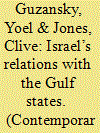

|
|
|
|
|
| Summary/Abstract |
By drawing on the literature about security regimes, this article posits the idea that a particular type of regime, which can be termed a “tacit security regime” (TSR), has begun to emerge between Israel, on the one hand, and several Gulf Arab states, on the other. It is a regime which, unlike liberal institutional variants that attempt to privilege the promotion of collective norms, remains configured around perceptions of threats to be countered and strategic interests to be realized. By examining the development, scope, and scale of this nascent TSR, this article explores the extent to which Israel, mindful of Washington, DC’s regional retrenchment, sees the emergence of such a regime as redefining the political and strategic contours of Israel’s relations with much of the Middle East.
|
|
|
|
|
|
|
|
|
|
|
|
|
|
|
|
| 6 |
ID:
156084
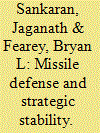

|
|
|
|
|
| Summary/Abstract |
South Korea is threatened by its troubled relationship with North Korea. North Korea possesses a large cache of missiles as well as chemical and biological weapons, and the future potential to mount nuclear weapons on its missiles. The United States is also challenged because of its defense commitments to Seoul. As a countermeasure, the United States and South Korea decided to deploy Terminal High Altitude Area Defense (THAAD) missile defenses in South Korea. However, China has objected. Chinese scholars believe the THAAD radar would be able to track Chinese inter-continental ballistic missiles, thereby weakening their deterrent. A technical analysis does not support this assertion. However, it is vital for South Korea, given its proximity and economic interdependence, to reassure China. South Korea should highlight that THAAD will be deployed by the United States Forces Korea and is not a commitment by Seoul to become part of U.S.-led missile defenses in the Asia-Pacific.
|
|
|
|
|
|
|
|
|
|
|
|
|
|
|
|
| 7 |
ID:
156088


|
|
|
|
|
| Summary/Abstract |
Military rapid response mechanisms are generally understood as troops that are on standby, ready to be deployed to a crisis within a short time frame. Yet, the overall track record of the existing multinational rapid response mechanisms within the European Union, the African Union, and North Atlantic Treaty Organization remains disappointing, and the United Nations does not even have a rapidly deployable capacity anymore. Meanwhile, despite that calls for the further development of these mechanisms are still being voiced politically, scholarly literature remains fragmented. This is problematic as many of the obstacles faced by these organizations are similar. This forum uniquely compares experiences from the four aforementioned organizations. Drawing on these insights, this introductory article identifies some key factors that hamper or enable the development and deployment of multinational rapid response mechanisms.
|
|
|
|
|
|
|
|
|
|
|
|
|
|
|
|
| 8 |
ID:
156090
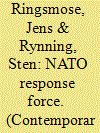

|
|
|
|
|
| Summary/Abstract |
This article reviews the gloomy saga of the EU Battlegroups, focusing on four questions: Where do they come from? What do they look like? What have they been hindered by? And where do they go from here? It builds upon earlier findings in the literature and adds novel insights based on original data. In doing so, the article pays particular attention to the standby nations’ constant calculation of political and financial costs. It argues that recognizing these cost–benefit calculations allows for identifying the most crucial areas to be tackled to make the EU Battlegroups functional. In addition, the article stresses that these considerations play out in a setting wherein the Battlegroups are just one among many policy instruments available for rapid response.
|
|
|
|
|
|
|
|
|
|
|
|
|
|
|
|
| 9 |
ID:
156089


|
|
|
|
|
| Summary/Abstract |
This article analyses the main challenges and future prospects of creating United Nations (UN) rapid reaction mechanisms, particularly in the light of past attempts and current discussions about a “UN Vanguard Force” in the wake of the High-Level Panel on Peace Operations report. The article reviews major initiatives (in particular lessons from the Standby High Readiness Brigade for UN Operations) and assesses the main achievements, failures, and challenges related to past UN-led rapid reaction mechanisms. In line with the overall aim of this special forum, the article highlights the future potentials and institutional, operational, financial, and political challenges that need to be overcome in order to design and create a pragmatic and effective rapid reaction tool at the disposal of the UN.
|
|
|
|
|
|
|
|
|
|
|
|
|
|
|
|
|
|
|
|
|